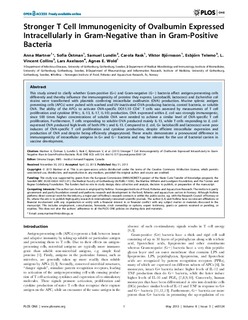Stronger T cell immunogenicity of ovalbumin expressed intracellularly in Gram-negative than in Gram-positive bacteria
Martner, Anna; Östman, Sofia; Lundin, Samuel; Rask, Carola; Björnsson, Viktor; Telemo, Esbjörn; Collins, L. Vincent; Axelsson, Lars; Wold, Agnes E.
Peer reviewed, Journal article
Accepted version
Permanent lenke
http://hdl.handle.net/11250/2481279Utgivelsesdato
2013Metadata
Vis full innførselSamlinger
- Artikler / Articles [1449]
- Publikasjoner fra CRIStin [2518]
Originalversjon
10.1371/journal.pone.0065124Sammendrag
This study aimed to clarify whether Gram-positive (G+) and Gram-negative (G−) bacteria affect antigen-presenting cells differently and thereby influence the immunogenicity of proteins they express. Lactobacilli, lactococci and Escherichia coli strains were transformed with plasmids conferring intracellular ovalbumin (OVA) production. Murine splenic antigen presenting cells (APCs) were pulsed with washed and UV-inactivated OVA-producing bacteria, control bacteria, or soluble OVA. The ability of the APCs to activate OVA-specific DO11.10 CD4+ T cells was assessed by measurments of T cell proliferation and cytokine (IFN-γ, IL-13, IL-17, IL-10) production. OVA expressed within E. coli was strongly immunogenic, since 500 times higher concentrations of soluble OVA were needed to achieve a similar level of OVA-specific T cell proliferation. Furthermore, T cells responding to soluble OVA produced mainly IL-13, while T cells responding to E. coli-expressed OVA produced high levels of both IFN-γ and IL-13. Compared to E. coli, G+ lactobacilli and lactococci were poor inducers of OVA-specific T cell proliferation and cytokine production, despite efficient intracellular expression and production of OVA and despite being efficiently phagocytosed. These results demonstrate a pronounced difference in immunogenicity of intracellular antigens in G+ and G− bacteria and may be relevant for the use of bacterial carriers in vaccine development.
